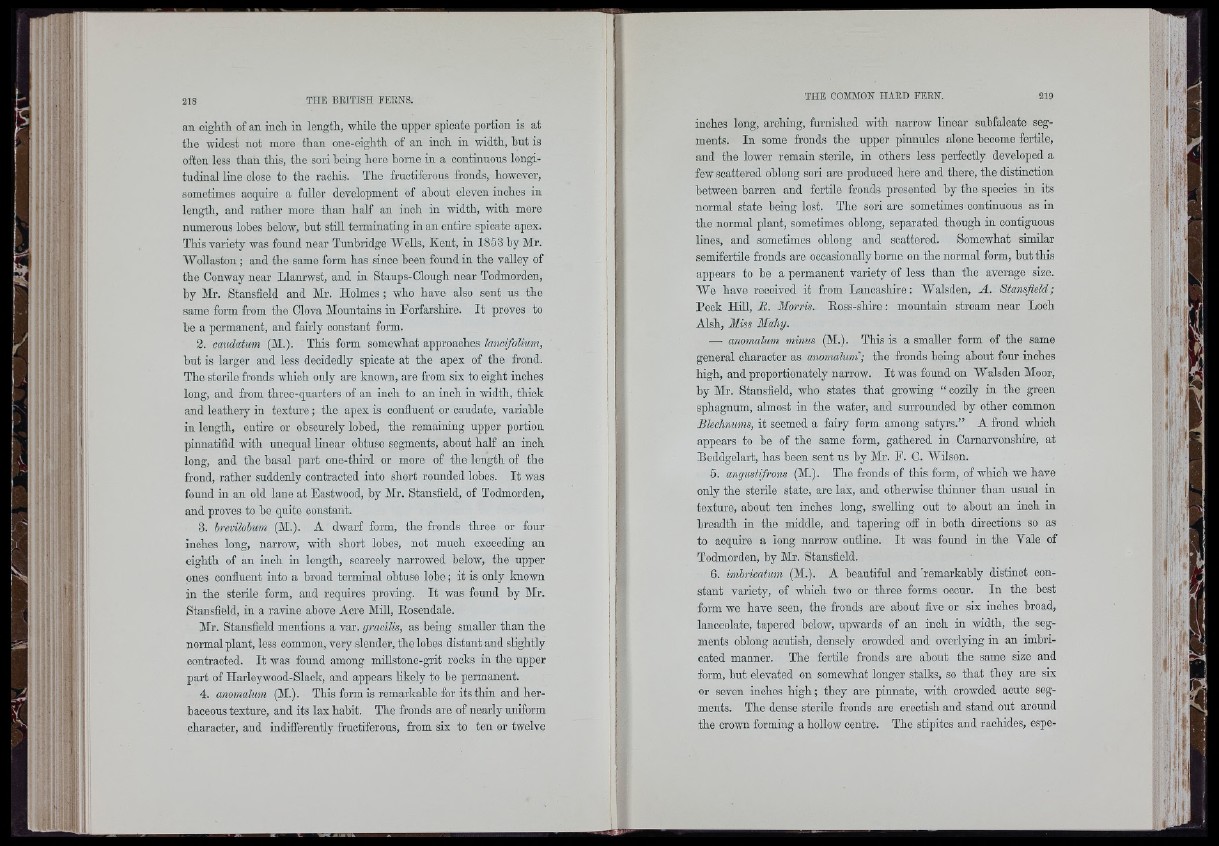
■fi: ■
: í i l l
TH E BRITISH FERNS.
an eighth of an inch in length, while the nppor spicate portion is at
the widest not moro than ono-oighth of an inch in width, but is
often less than this, the sori hoing here borne in a continuous longitudinal
lino close to tho raohis. The fructiferous fronds, however,
sometimes acquire a fuller dovelopmont of about eleven inches in
length, and rather more than half an inch in width, with more
numerous lobes below, hut still torminating in an entire spicate apex.
This variety was found near Tunbridge "Wells, Kent, in 1853 by Mr.
Wollaston ; and tho same form has since been found in the valley of
the Conway near Llanrwst, and in Staups-Clough near Todmorden,
by Mr. Stansfield and Mr. Holmes ; wlio have also sent us the
same form from tho Clova Mountains in Forfarshire. It proves to
be a permanent, and fairly constant form.
2. caudatum (M.). This form somewhat approaches lancifolium,
but is larger and less decidedly spicate at the apex of the frond.
The sterile fronds which only are known, aro from six to eight inches
long, and from three-quarters of an inch to an inch in width, thick
and leathery in texture; the apex is confluent or caudate, variable
in length, entire or obscurely lobed, the remaining upper portion
pinnatifid with unequal linear obtuse segments, about half an inch
long, and tho basal part one-third or more of the length of the
frond, rathor suddenly eontraotcd into short rounded lobes. It was
found in an old lane at Eastwood, by Mr. Stansfield, of Todmorden,
and proves to be quite constant.
3. hrcvilohum (M.). A dwarf form, the fronds throe or four
inches long, narrow, with short lobes, not much exceeding an
eighth of an inch in length, scarcely narrowed helow, the upper
ones confluent into a broad terminal obtuse lobe; it is only known
in the sterile form, and requires proving. It was found by Mr.
Stansfleld, in a ravine above Acre Mill, Rosendale.
Mr. Stansfiold mentions a var. gracilis, as being smaller tban tbe
normal plant, less common, very slender, the lobes distant and slightly
contracted. It was found among miUstone-grit rooks in the upper
part of Harleywood-Slaok, and appears likely to he permanent.
4. anomalum (M.). This form is remarkable for its thin and herbaceous
texture, and its lax habit. The fronds are of nearly uniform
character, and indifferently fructiferous, from six to ten or twelve
THE COMMON HAED FEEN. 2 1 9
inches long, arching, furnished with narrow linear subfalcate segments.
In some fronds the upper pinnules alone become fertile,
and the lower remain sterile, in others less perfectly developed a
few scattered ohlong sori arc produced hero and there, the distinction
between barren and fertile fronds presented by tbe species in its
normal state being lost. The sori are sometimes continuous as in
the normal plant, sometimes oblong, separated though in contiguous
lines, and sometimes oblong and scattered. Somewhat similar
semifcrtüe fronds are occasionally borne on tbe normal form, but this
appears to be a permanent variety of less than the average size.
Wo have received it from Lancashire: Walsden, A. Stansfield;
Pock HiU, R. Morris. Eoss-shire: mountain stream near Loch
Alsh, Miss Mahy.
— anomalum minus (M.). This is a smaller form of the same
general character as anomalum; the fronds being about four inches
high, and proportionately narrow. It was found on Walsden Moor,
by Mr. Stansfield, who states that growing “ cozily in the green
sphagnum, almost in the water, and surrounded by other common
Blechnums, it seemed a fairy form among satyrs.” A frond which
appears to be of the same form, gathered in Carnarvonshire, at
Beddgelart, has been sent us by Mr. F. C. Wilson.
5. angustifrons (M.). The fronds of this form, of which we have
only the sterile state, are lax, and otherwise thinner than usual in
texture, about ten inches long, swelling out to about an inch in
breadth in the middle, and tapering off in both directions so as
to acquire a long narrow outline. It was found in the Vale of
Todmorden, by Mr. Stansfiold.
6. imbricatum (M.). A beautiful and 'remarkably distinct constant
variety, of which two or three forms occur. In the best
form we have seen, the fronds are about five or six inches broad,
lanceolate, tapered holow, upwards of an inch in width, the segments
oblong acutish, densely crowded and overlying in an imbricated
manner. The fertile fronds are about the same size and
form, but elevated on somewhat longer stalks, so that they are six
or seven inches high; they aro pinnate, with crowded acute segments.
The dense sterile fronds are eroctish and stand out around
the crown forming a hollow centre. The stipites and rachides, espe'
■ ' r
I
"i;r
if
.4
i l l Ik ,
;i
ri , i .
1 4
Ijlil
. i
I Ir
! i
ir i
i